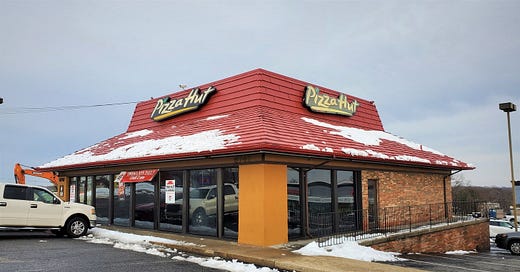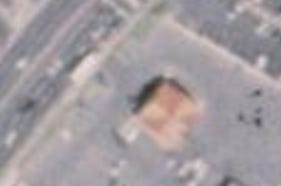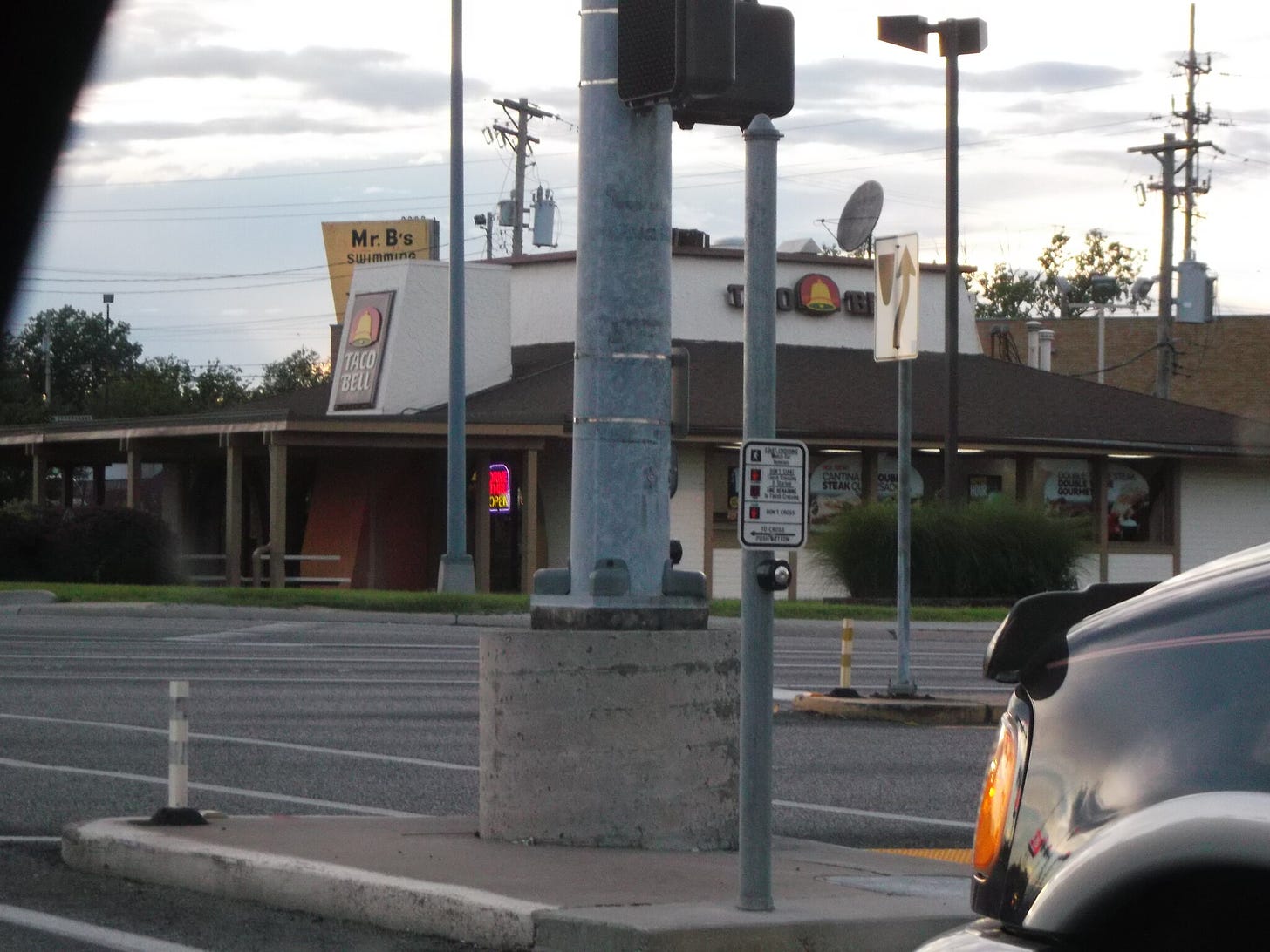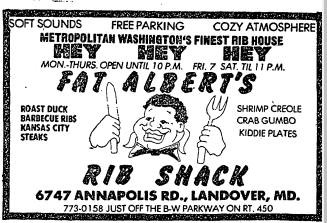Didn't Used To Be a Pizza Hut
Or a story of serious detective work in the field of suburban archaeology
This building outside a strip plaza in Landover, Maryland, has been driving me crazy for almost a month:
Notice anything unusual about it? I did. For one, it lacks Pizza Hut’s trademark trapezoidal windows. Secondly, it’s a square, not a rectangle, and the roof is not quite the trademark Pizza Hut roof. Third, that orange pillar at the corner looks out of place, suggesting exterior alterations.
In other words, when I drove past this, I immediately suspected that it was not built to be a Pizza Hut—making it the only freestanding Pizza Hut I’ve ever seen that occupies a pre-existing building. There’s Used to Be a Pizza Hut, a blog that documents various and often amusing reuses of vacated Pizza Hut buildings. Call this Didn’t Used to Be a Pizza Hut.
What follows is the saga of identifying the original builder/tenant of this structure, and piecing together its history over half a century. It’s every bit as tricky and puzzling as detective work or archaeology. I love the challenge, and I also love uncovering bits of very recent, seemingly ordinary, and mostly forgotten commercial and land-use history. Enjoy.
To start, I was not positive that this wasn’t an original Pizza Hut—sometimes companies build one-off or not-quite-standard structures. So first I consulted aerial imagery at Historic Aerials and at an incredible online archive of Prince George’s County aerial imagery. Sure enough, imagery from 1977 and 1980 revealed that the small square building used to sport an angled roof, which, as one set of color imagery reveals, was orange. The whole property, including the associated shopping center, dates to 1971.
I had posted photos of the Pizza Hut building on Twitter as well, and someone else dug up the same old aerial image, showing the building with a very different, obviously-not-a-Pizza-Hut roof.
Armed with new and old images, I went to Facebook, where I posted them to three D.C.-region groups to see if anyone could identify the original building. Usually, this is pretty simple: an old-timer either remembers the location in question (“That used to be X. I went on a date there in 1975!”) or recognizes the distinctive architectural elements as belonging to a particular, usually defunct, restaurant or retail chain.
This time, however, no dice. But I did get a lot of guesses. About half the guesses were Howard Johnson’s.
Orange pitched roof, steeple in the middle, squarish and small. Bingo!
But that would be too easy.
First of all, the Howard Johnson’s structures that looked like this were motel offices, not restaurants. The restaurants were much larger, and more rectangular. And this couldn’t be a motel office, because there was no motel-type structure nearby, and because an outparcel in a strip plaza will almost always be a restaurant (or bank).
Guesses cycled through a lot of other chains that once had locations in the region, with various sorts of angled roofs: Three Chefs, Burger Chef, Little Tavern, Tops, Red Barn, and more. All of these are good guesses, but none are exact matches for a four-sided angled roof on a small square building.
Finally, one person suggested a vintage Krispy Kreme donut shop. I’ve seen them before, and they resemble the building. I had a lead, which necessitated more sleuthing. Specifically, I had to actually find a couple of vintage Krispy Kreme buildings that were still standing, and there aren’t many of them left. So I went to Flickr, searched “vintage Krispy Kreme,” and found some photos with addresses, so I could look them up on Google Maps. The first one had been torn down, but I found a couple that were still standing. Like this:
I was hopeful at first, because of the close resemblance: four-sided angled roof, steeple, square, small. Some old Krispy Kremes had brick walls and all-glass fronts, which looked a lot like the Pizza Hut. But there were a few issues.
One is that Krispy Kreme’s signature roof color is green, not orange. Another is that the peaks on the sides of the roof are steeper and shorter than the one at the front, whereas all four sides on the building in question appear to have the same dimensions. But the biggest issue is that the entire peaked-roof structure on an old Krispy Kreme is really just a vestibule for a larger building. Maybe Krispy Kreme constructed a mini version, but nothing I could find was a visual or architectural match.
Back to square one. It occurred to me at this point that the answer might be lost unless I could find someone who actually remembered it. While this structure screamed “chain-specific model building,” it could have been a one-off copy or knock-off, just one single restaurant owner aping the style of a Howard Johnson’s or Krispy Kreme. If it was a one-off, and a fairly short-lived one, it was possible nobody ever mentioned it in print, and that the information had simply never been captured. All I’d be able to say, then, was that it was something other than a Pizza Hut. But that just wasn’t good enough.
I did some futile internet searches and re-upped my Twitter question on the building. I asked Dan Reed, an urbanist I know in not-too-far-away Silver Spring, if he had any idea. He remembered a Taco Bell with the old logo in that strip plaza, and had shopped there years ago. But other than that, nothing.
Then I got another intriguing answer: Zantigo, an erstwhile Mexican fast-food chain from the late 1960s that was eventually acquired by Taco Bell. They had a distinctive roof like the current Pizza Hut, meaning this could be an intermediate tenant. Meaning that almost-Pizza-Hut roof might not even have been built by Pizza Hut. Like so:
The roof and the Taco Bell seemed like matches, but it still didn’t answer what the structure was originally, nor was I sure it was even correct. Once again, the dimensions didn’t seem quite right—Zantigo looked like a fairly larger building.
Then I got another tantalizing clue: a fellow who does commercial property work had looked up the address, and found a 1981 record identifying it as “Studio 450 Restaurant” (450 is the number of the highway it’s on.) Someone else found a newspaper clip, also from 1981, about a fire at the building. It confirmed the Studio 450 name, and also identified a previous tenant as “Fat Albert’s,” a BBQ/rib joint, in the late 1970s. Neither name brought back anything online. But the newspaper clip did unquestionably describe the building:
Next I looked up the address on Maryland’s official property records website, but the records available online only went back to 2003. And, oddly enough, their records identified the building as much later: “Primary Structure Built: 1984.”)
I was pretty much at a loss, and had resolved to try digging up the full records at the county clerk’s office. But for now I had cold case.
Until somebody on one of the Facebook groups came through, big time. An August 1971 newspaper clip, which he found through his public library system in Montgomery County, Maryland, identified the address as a branch of a small chain based in Maryland’s Eastern Shore, called “English’s Chick’n Steak House”:
Here, in a 1969 article about the chain’s expansion into the Maryland mainland, is a photo of their standard building. (The object on the steeple is a chicken!)
The rest fell into place too. A 1974 ad identified it as Fat Albert’s, meaning it didn’t last very long after English’s built it from scratch.
A 1980 ad showed that in the intervening years it had become another barbecue restaurant, Maryland House of Ribs, and was currently for sale.
A 1981 ad confirms that by then it was Studio 450. (The shopping center also had a different name back then, underscoring how tricky this kind of work can be.)
And an early 1985 ad was looking for applicants to work at the soon-to-open Pizza Hut.
So: The 1981 fire must have destroyed the original roof, the building must have sat vacant for a few years, and then in 1984—the date the property record identifies as the year built—it must have gotten its new roof and been substantially remodeled, right before Pizza Hut actually opened in early 1985.
And there you go.
Now to go do some reading about English’s Chick’n Steak House, this little chain nobody had guessed or remembered. However, I could find absolutely nothing online about it, save a couple of very old digitized federal government publications—one of which was a list of stores and restaurants hiring high-school-age children below the minimum wage under an old labor program!
I’d dug up a small chain that had left almost no trace of its erstwhile existence. And I’d figured out all of this because I pulled off the highway to photograph a Pizza Hut.
Well, there’s one more twist. But first a few closing thoughts.
Generally speaking, almost any old restaurant or retail chain—at least any of the ones I’ve ever looked up—will have some sort of fan base. A blog, a forum, a Facebook group: some sort of compendium of memories, old locations, memorabilia, scans of menus, what have you. People will remember gathering there, working there, going to breakfast, after church, or on a first date. Even small local or regional chains usually leave a nostalgia footprint.
The lack of any such material online for English’s is really intriguing to me. It’s kind of amazing that with the help of some Maryland old-timers, I discovered an almost-forgotten local chain, whose physical footprint is almost gone. There is very little evidence that this chain ever existed at all.
And here’s the twist: it appears that English’s Chick’n Steak House was not a small independent chain of its own, but rather a concept introduced by a parent company: the English Company, which operated diner-style restaurants on the Eastern Shore. That company is defunct, but only as of 2015. Neither of these articles I’ve just linked mention the Chick’n Steak House concept.
How much early American suburban history—with its rapid growth; its human scale; its creative entrepreneurship; its lightly regulated, sometimes mixed-use nature; and its hint of frontier rough-and-tumble—is waiting there to be documented before it slips forever out of living memory?
There’s a term in digital preservation and music called “the deleted years,” referring to the fact that huge numbers of files, from personal photos to digital music libraries, effectively disappeared in the mid-to-late 2000s. Much of it resides on broken portable devices, obsolete and retired computers, or inaccessible web accounts. In some ways, America’s first couple of generations of suburbia is a period of “deleted years” for the built environment. Aside from property records and old memories, very little of this landscape’s workaday history has been preserved in any centralized fashion. 50, 60, 70 years out, the simple question “What did that used to be?” is already becoming difficult to answer.
I know that’s a lot to write about a Pizza Hut. I’m beyond thankful to have the time to write this kind of thing, an audience to read it, and people willing to pay for it. If you made it to the end, thanks for reading. And if you, like me, sometimes feel like writing off “the suburbs,” remember this way of looking at them too.
Image credits: Howard Johnsons motel office, Ed Bierman/Flickr, CC BY 2.0; Krispy Kreme, Thomas Hawk/Flickr, CC BY-NC 2.0; Zantigo, Bobby P./Flickr, CC BY 2.0
Related Reading:
Kinney Shoes’ Architectural Afterlife
Please consider upgrading to a paid subscription to help support this newsletter. You’ll get a weekend subscribers-only post, plus full access to the archive of over 200 posts and growing. And you’ll help ensure more material like this!

















Love the obsessive digging to find the answer. The big about chain restaurants reminds me of this person that writes the blog here http://www.brokenchains.blog/ The blog details going to existing restaurants that once belonged to a chain. So, obviously, English’s Chick’n Steak House wouldn't fit neatly into his domain, but maybe he has access to data or people on some more obscure chains? Regardless, thanks for detailing your process and keep up the good work!
Loved the piece, Addison. Appreciate the follow up from the original question. Can we do Simmons Mobile Market? My favorite Wheaton memories as a kid in the '50's!